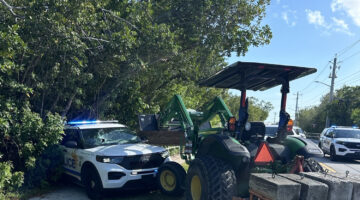Communities Benefit from Flood Protection Projects in Florida
ORLANDO, Fla. – Florida communities that took steps to reduce disaster risks can attest to their benefits after Hurricane Irma made landfall.
Hallandale Beach, Indialantic and Key Largo completed FEMA- and state-funded projects that reduced or eliminated damage from wind and flooding during the 2017 hurricane. Below are their stories.
Hallandale Beach, Broward County
For years, residents in the low-lying southeast quadrant of Hallandale Beach had been plagued with drainage issues that caused flooding. The area had no formal surface-water management system to treat stormwater runoff.
The city came up with a solution to prevent future flooding: constructing a drainage system. The proposed project consisted of a system of inlets, culverts and reconstructed roadside swales that would discharge stormwater to drainage wells via two pump stations.
After the southeast quadrant construction began in 2012, Hallandale Beach requested additional funding for a drainage system in the northeast quadrant of the city.
When Hurricane Irma battered the city, there were reports of downed powerlines and road closures, but the storm validated the project’s success. The floodwaters receded as the pump stations controlled the floodwater. There was no reported flood-related loss of life or property in the community.
Indialantic, Brevard County
Residents of Indialantic made the decision to protect a key government building housing the town hall and police department from potential storm damage. The town is on a barrier island and is susceptible to high waves and the strongest winds when hurricanes make landfall.
The structural integrity of the building was not a concern, but its windows and doors were not high-impact resistant. Potential storm damage to the building could have disrupted town services, including those provided by the police.
In 2006 the town installed hurricane screens on all windows and doors certified to meet impact standards for winds up to 130 mph.
Hurricane Irma—striking Indialantic with gusts between 90 and 94 mph—validated the success of the new screens. Damage there included flooding, downed tree branches, damaged roofs and broken glass from wind-blown debris. However, town hall remained intact.
Key Largo, Monroe County
During its decades-long existence, the character of a 22-acre oceanfront recreational vehicle park in Key Largo gradually changed. Residents in the high-risk flood area had constructed additions to RVs and other structures that failed to comply with local zoning and created an overcrowded development with fire hazards.
After a fire destroyed many homes, residents agreed to a new site plan in 2011 to create the Key Largo Ocean Resort modular-home community. The plan included elevating new homes on stilts—piers or columns—made of concrete reinforced with rebar.
Hurricane Irma put the stilts to the test when it rolled into the Florida Keys with winds in excess of 130 mph and a storm surge of more than 3 feet. While Irma left a trail of destruction in the Keys, all new homes in the condominium development went unscathed.
Visit www.FEMA.gov/IrmaFL, or follow us @FEMARegion4 on Twitter and on FEMA’s Facebook page. Watch the video on the Evolution of Mitigation, covering the Florida Keys after Irma.
[livemarket market_name="KONK Life LiveMarket" limit=3 category=“” show_signup=0 show_more=0] 



No Comment